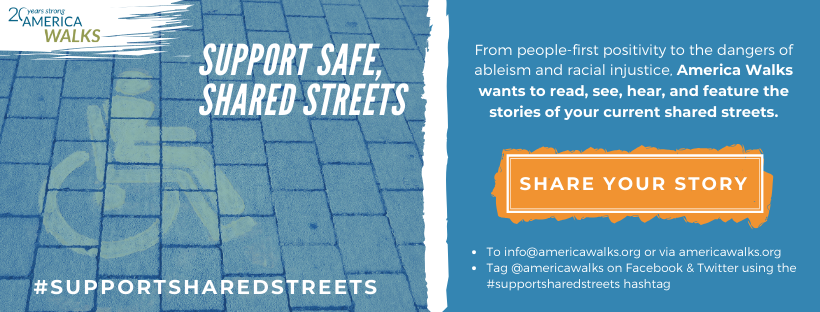It is clear that too many Americans lack the people-first street design to stay apart, safe, and healthy during this COVID-19 pandemic. Racial, ability, and income disparities have been made even more obvious as we see striking community differences in accessible and safe places for walking and moving.
The differences are sparking important and needed conversations and actions for how we can better share our streets. There is an urgent need for mobility justice and active transportation solutions that work for all.
Complete the form linked here. Send larger photo/video files to info@americawalks.org for a possible feature on our social media, blog, or newsletter.
*We may not be able to reply to all of you. Please know that we appreciate your time and dedication to support and tell stories around safer, shared streets!
Some ideas or prompts for your #supportsharedstreets story submission:
- Does your community have open or shared streets right now? How are they working out?
- What kind of community resilience have you seen around the effort to share streets while promoting safety
- If you are a person who has disabilities, what is your experience with regards to leaving, or not being able to leave, your home for movement, physical activity, and active transportation?
- How do you see, either now or in the future, people-first policies and planning being put into place in response to the pandemic?
- What is your utopian vision of shared or open streets in your neighborhood? How does that compare to your current reality?
- Draw a picture that highlights the ways you see or hope for shared streets to be supported – now and in the future (bonus: get the kids involved).
- Take a video (while social distancing) that shows us the ways your community is sharing streets and sidewalks.
- If you aren’t able to leave your home, take a video telling us about that experience and how it relates to walking and moving.
- Write a brief, open letter plea to your local leaders about what you need right now when it comes to shared streets and accessibility: open streets? More park access? Less policing/fining? Zoom meetings where advocates can speak to accountable local leaders?
- Write a poem or an ode to walking, moving, and/or supporting shared streets.
- What are your current or future goals for walking and moving as active transportation in regards to COVID-19?

